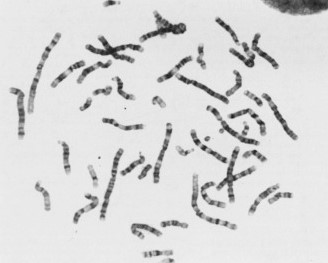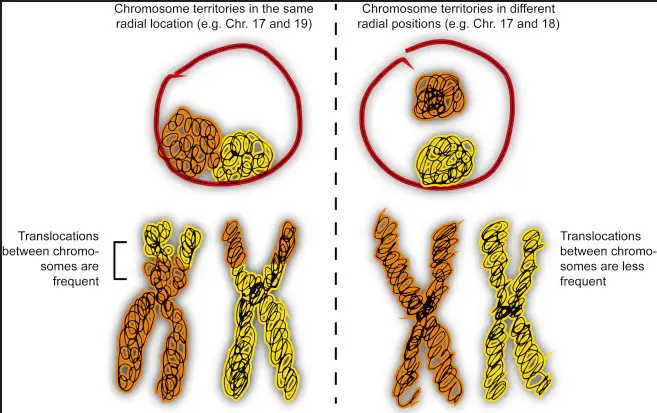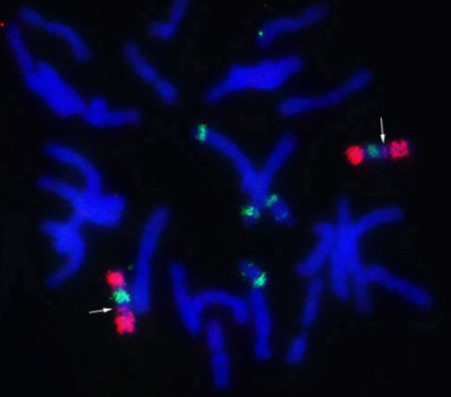Chromosomes, the carriers of genetic information in living organisms, are at the heart of our understanding of genetics and heredity. Their visualization and analysis through various techniques offer insights into genetic disorders, evolutionary biology, and species differentiation. Among these techniques, chromosome banding and chromosome painting stand out for their distinct approaches and contributions to cytogenetics and molecular biology.
Chromosome banding and chromosome painting are two methods used to visualize and differentiate between the multiple chromosomes in an organism. Chromosome banding involves staining chromosomes to produce distinct bands that identify chromosome features and abnormalities. On the other hand, chromosome painting uses fluorescent probes to bind specific DNA sequences, illuminating entire chromosomes or regions of interest in different colors, enabling detailed chromosomal analysis and comparison.
The relevance of these techniques extends beyond basic science, affecting diagnostic practices and research methodologies. By providing a roadmap of the chromosomes, they assist in the diagnosis of genetic conditions, the study of chromosomal abnormalities, and the exploration of the genetic relationships between species. These methods have revolutionized our ability to observe and understand the complexities of the genome, laying the groundwork for advances in genetic research, medicine, and beyond.

Chromosome Basics
Structure and Function
Chromosomes are long, thread-like structures made of DNA and proteins. They are found in the nucleus of most living cells and carry genetic information. Each chromosome has a constriction point called the centromere, which divides it into two sections or “arms.” The shorter arm is labeled “p” for “petite,” and the longer arm is labeled “q” for “queue.”
Chromosomes play a crucial role in genetic inheritance. During reproduction, chromosomes ensure DNA is accurately copied and distributed in the process of cell division, allowing genetic information to be passed from parents to offspring. This genetic material determines everything from eye color to susceptibility to certain diseases.
Chromosome Visualization
Historical Perspective on Chromosome Study
The study of chromosomes began in the late 19th century with scientists like Walther Flemming, who discovered chromatin and mitosis. However, the true structure and significance of chromosomes remained elusive until the development of better staining techniques and microscopes.
Evolution of Visualization Techniques
Over time, scientists have developed various methods to visualize chromosomes more clearly:
- Light microscopy allowed the basic structure of chromosomes to be observed.
- Staining techniques like Giemsa stain made it possible to see chromosomes in different colors.
- Electron microscopy provided a more detailed view at the molecular level.
These advancements laid the groundwork for more sophisticated chromosome analysis techniques like banding and painting.
Chromosome Banding
Overview
Chromosome banding is a technique used to visually distinguish between different regions of a chromosome. This is achieved by treating chromosomes with specific chemicals that stain regions differently, creating a pattern of bands.
Types of Chromosome Banding
- G-banding: Uses the Giemsa stain to produce bands along the chromosome.
- Q-banding: Uses quinacrine mustard, which fluoresces under UV light.
- C-banding: Highlights the centromeres of chromosomes.
- R-banding: Produces bands complementary to G-banding, heating the chromosomes before staining with Giemsa.
Techniques and Processes
G-banding
- Treat chromosomes with a mild protease.
- Stain with Giemsa.
- Observe bands that reflect the distribution of A-T rich DNA.
Q-banding
- Stain chromosomes with quinacrine mustard.
- View under UV light to see fluorescent bands.
C-banding
- Treat chromosomes to remove non-centromeric DNA.
- Stain with Giemsa to highlight the centromeres.
R-banding
- Heat chromosomes.
- Stain with Giemsa to produce bands complementary to G-banding.
Applications
- Diagnosis of genetic disorders: Identifies chromosomal abnormalities.
- Evolutionary biology studies: Examines chromosomal changes over time.
- Species differentiation: Helps differentiate between closely related species.
Chromosome Painting
Overview
Chromosome painting involves using fluorescent in situ hybridization (FISH) to attach fluorescent probes to specific DNA sequences on chromosomes. This technique illuminates entire chromosomes or parts of chromosomes in different colors.
Introduction to Fluorescence In Situ Hybridization (FISH)
FISH is a powerful technique that allows scientists to locate the position of specific DNA sequences on chromosomes. It uses fluorescently labeled probes that bind to those sequences.
Development of Chromosome Painting
Chromosome painting has evolved from FISH to become a method for studying the complex organization of the genome. It enables the identification of structural variations and the comparison of genomic sequences between individuals or species.
Techniques and Processes
FISH Procedure for Chromosome Painting
- Prepare the DNA probe with fluorescent tags.
- Denature the DNA in the sample to make it single-stranded.
- Hybridize the probe to the sample DNA.
- Visualize the hybridized probes under a fluorescence microscope.
Spectral Karyotyping (SKY)
SKY involves using multiple fluorescent probes, each in a different color, to paint each chromosome in a unique color. This allows for the detailed analysis of all chromosomes in a single view.
Applications
- Comparative genomic hybridization: Compares genomic content.
- Identifying chromosomal abnormalities: Detects anomalies like translocations, deletions, and duplications.
- Research in genetics and evolution: Studies genetic relationships and evolutionary changes.

Comparative Analysis
Similarities
Objectives in Genetic Studies
Both chromosome banding and chromosome painting aim to enhance our understanding of genetics. These techniques are pivotal for identifying genetic information on chromosomes, crucial for diagnosing genetic disorders, and advancing our knowledge in genetic research and evolution.
Contribution to Cytogenetics
Chromosome banding and painting significantly contribute to cytogenetics by providing detailed views of chromosomes. They allow researchers to observe chromosomal structures, identify abnormalities, and understand genetic variations across different organisms.
Key Differences
Methodology and Technology Used
- Chromosome banding utilizes specific stains that react differently with various parts of the chromosome, revealing patterns that can be seen under a light microscope.
- Chromosome painting employs fluorescent DNA probes that bind to specific sequences, making them visible under a fluorescence microscope. This technique is more technologically advanced and requires specific equipment.
Types of Information Provided
While chromosome banding offers a general overview of chromosomal structure and can identify large-scale genetic anomalies, chromosome painting provides a more detailed analysis, pinpointing specific DNA sequences and revealing intricate chromosomal rearrangements.
Specificity and Resolution
- Chromosome banding has lower specificity and resolution compared to chromosome painting. It can identify broader chromosomal changes but might miss smaller, more specific genetic alterations.
- Chromosome painting, with its use of fluorescent probes, achieves high specificity and resolution, capable of detecting minute genetic differences and abnormalities.
Challenges and Limitations
Chromosome Banding
Resolution Limitations
One of the main challenges of chromosome banding is its limited resolution. It can primarily detect larger chromosomal abnormalities but might not be effective for identifying smaller genetic mutations or subtle chromosomal changes.
Sample Preparation Complexity
The process of preparing samples for chromosome banding is time-consuming and technically demanding. It requires precise conditions for staining and analyzing chromosomes, which can be a limitation in some research and clinical settings.
Chromosome Painting
Cost and Accessibility
Chromosome painting, especially techniques like FISH and SKY, involves expensive equipment and materials, making it less accessible for all laboratories. The cost factor can be a significant barrier to its widespread use.
Interpretation of Complex Results
The complexity of results obtained from chromosome painting can be challenging to interpret. This technique generates a vast amount of data, requiring specialized knowledge and software for analysis, which can be a limitation for some research and clinical applications.
Future Directions
Technological Advances
Potential Improvements in Resolution and Specificity
Future advancements in chromosome banding and painting technologies aim to increase their resolution and specificity. Innovations may allow for the detection of even smaller genetic changes, enhancing diagnostic accuracy and research capabilities.
Integration with Other Genetic Technologies
The integration of chromosome banding and painting with other genetic technologies, such as next-generation sequencing (NGS) and CRISPR, promises to revolutionize genetic analysis. Combining these techniques could lead to comprehensive genomic studies, offering a fuller picture of genetic makeup and abnormalities.
Applications in Medicine and Research
Personalized Medicine
Chromosome banding and painting are key players in the development of personalized medicine. By identifying genetic mutations and variations, these techniques can help tailor treatments to individual genetic profiles, improving treatment outcomes and reducing side effects.
Advanced Genetic Research
These methods are also pushing the boundaries of genetic research, enabling scientists to explore complex genetic questions, understand evolutionary processes, and uncover the genetic basis of many diseases. Their continued evolution will likely lead to significant breakthroughs in genetics and biology.

Frequently Asked Questions
What is chromosome banding?
Chromosome banding is a cytogenetic technique where different stains are applied to chromosomes. This process results in the appearance of unique bands along each chromosome. These bands are useful for identifying chromosomal structures and any potential genetic abnormalities. This method is pivotal in diagnosing genetic disorders, as it allows scientists and medical professionals to see structural changes in chromosomes.
How does chromosome painting differ from banding?
Unlike chromosome banding, which uses stains to reveal bands that distinguish chromosome features, chromosome painting employs fluorescent DNA probes that specifically bind to sequences of DNA across the chromosome. This results in chromosomes or their parts being lit up in various colors under a fluorescence microscope. Chromosome painting provides a more detailed view of chromosome organization and is particularly useful for identifying chromosomal rearrangements and similarities among species.
What are the applications of chromosome banding and painting?
Chromosome banding and painting are essential in both research and clinical settings. They are used for diagnosing genetic diseases, identifying chromosomal abnormalities, studying evolutionary relationships among species, and understanding genetic diversity. Banding techniques like G-banding are routinely used in prenatal testing and cancer diagnosis, while chromosome painting aids in detailed genomic research, offering insights into genome structure and function.
Can chromosome painting identify all genetic abnormalities?
While chromosome painting is a powerful tool for identifying a wide range of chromosomal abnormalities, including translocations, inversions, and deletions, it may not detect all genetic mutations. Smaller mutations, such as point mutations, require more precise molecular techniques for identification, such as sequencing. However, chromosome painting is invaluable for comprehensive chromosomal analysis and the study of complex genomic rearrangements.
Conclusion
Chromosome banding and chromosome painting are cornerstone techniques in the field of genetics, each with its unique approach to visualizing chromosomes and identifying genetic information. While banding techniques offer a broad overview of chromosomal structures and abnormalities, chromosome painting allows for a more detailed and colorful representation of chromosomes, enabling precise identification of genetic rearrangements and comparisons across species. Together, these methods provide critical insights into genetic diseases, evolutionary biology, and the intricate workings of the genome.
The advancements in chromosome analysis represented by banding and painting techniques have significantly impacted genetic research and diagnostics. They have improved our understanding of genetic disorders, facilitated the study of chromosomal changes associated with various diseases, and contributed to the exploration of genetic relationships among organisms. As technology progresses, these techniques will continue to evolve, further enhancing our ability to decipher the complex language of chromosomes and unlock the secrets of our genetic code.

